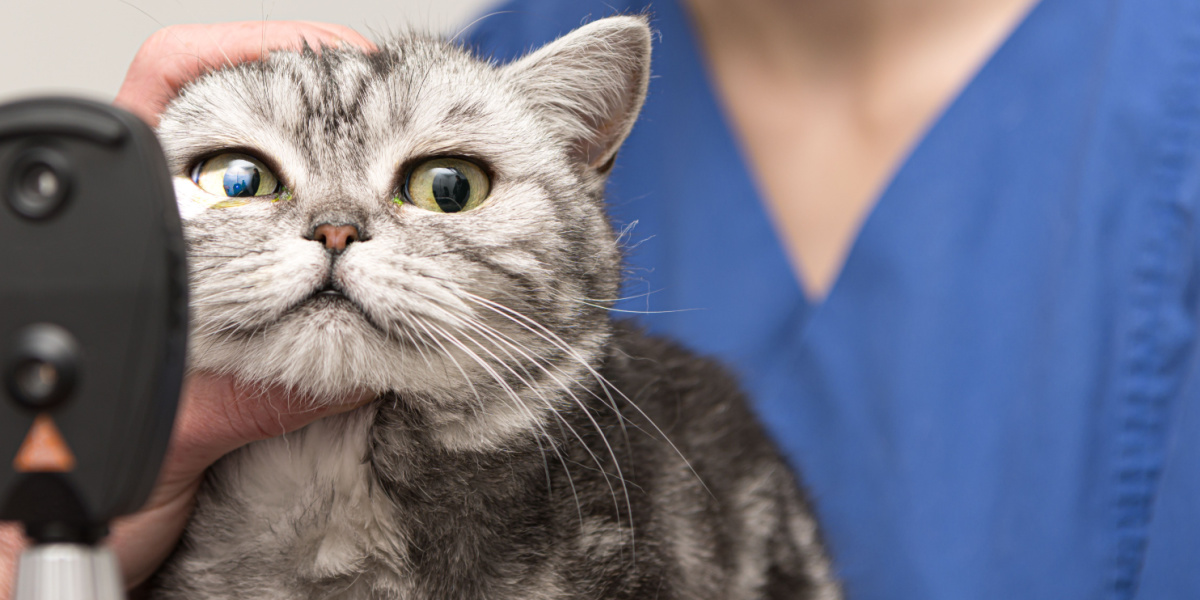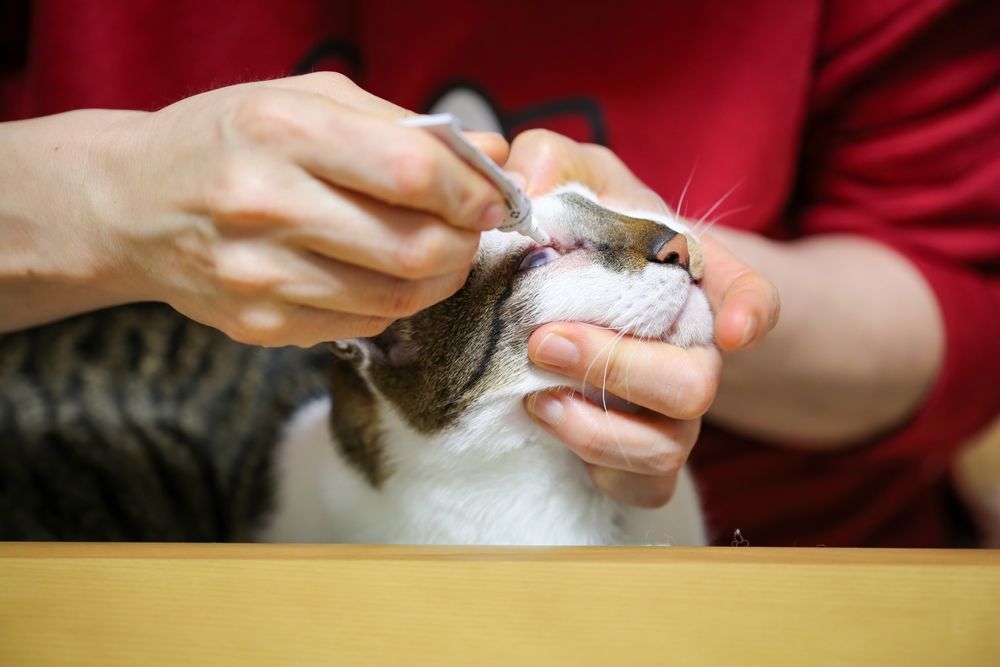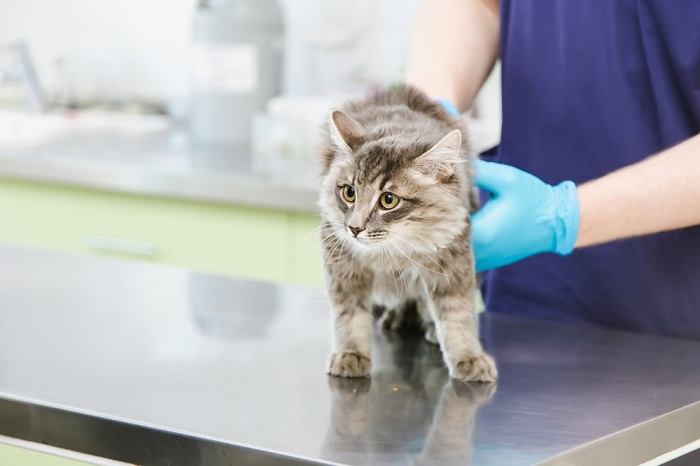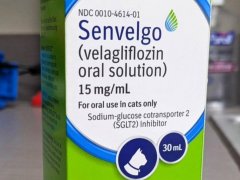
Shutterstock.com
Terramycin is the brand name for an eye ointment medication containing two antibiotics: oxytetracycline and polymyxin B. It’s generally used in cats to treat a variety of bacterial eye problems, including conjunctivitis and corneal ulcers. It comes as a thick ointment that needs to be carefully applied to the surface of the eye.
In this article, you’ll learn what Terramycin is used for in cats, how it works, side effects to monitor for, and some frequently asked questions.
Terramycin for Cats Overview

About Terramycin for Cats
Terramycin is a brand name for a prescription combination eye antibiotic ointment containing the antibiotics oxytetracycline and polymyxin B as its main ingredients. Terramycin is manufactured by Zoetis Animal Health.
Oxytetracycline is a member of the tetracyclines group of antibiotics. These are broad-spectrum antibiotics that work against both gram-positive and gram-negative bacteria. Oxytetracycline works to kill bacteria by disrupting their ability to make proteins. Tetracyclines have good activity against several types of bacteria, including Chlamydia and Mycoplasma which can cause conjunctivitis (pink eye) in cats.
Polymyxin B is actually derived from a bacteria, Bacillus polymyxa. It rapidly kills susceptible bacteria by making their cell membrane more permeable and vulnerable.
Both ingredients are antibiotics and are not considered effective against viruses or fungal infections.
Ophthalmic terramycin is generally used to treat pet cats with conjunctivitis when either Chlamydia or Mycoplasma species of bacteria are confirmed, or at least suspected to be involved. Because conjunctivitis in cats can also commonly have viral causes (such as feline herpesvirus and feline calicivirus) an antibiotic ointment should only be used for the treatment of eye infections under the direction of a veterinarian, when bacterial inflammatory conditions are suspected.
Dose of Terramycin for Cats
A single dose of terramycin ophthalmic ointment for cats is usually a strip of ointment long enough to cross the surface of the eye. This is typically about a gram of ointment. This is the same for all cats, whatever their breed or size. The amount given to kittens is generally slightly smaller, as the amount needed to cover the surface of their smaller eyes is less.
Terramcyin therapy may be administered to a cat anywhere from every 12 hours to every 6 hours. This equals 2–4 times a day, evenly spread across the surface of the eye.
When prescribed, your veterinarian will explain proper use of this medication, including how often this ointment should be applied and whether one or both eyes need to be treated.
How To Administer Terramycin to Cats
Terramycin only comes in an ointment form, to be applied to the surface of the eye (cornea). This can be a little tricky in some cats, but try the following approach for this or any application of antibiotic ophthalmic ointment/drops.
With your cat sitting on your lap facing away from you, gently tilt their head up so you can clearly see the eye. Keeping gentle leverage under the chin, use your thumb to raise the upper lid and your pointer finger to lower the bottom lid. With your other hand, apply the ointment to the surface of the eye in a small strip by gently squeezing the tube.
Do not let the tube touch the eye. Allow the ointment to squeeze out of the tube and land on the eye surface. After applying, use your thumb and pointer finger to gently close the lids, so the ointment spreads across the eye surface. When your cat blinks, this will also help to spread out the medication.
Because Terramycin is an ointment that coats the surface of the eye, it should be administered after any eye drop solutions that have also been prescribed for your cat. Administering an ointment prior to a liquid solution will prevent the liquid solution from reaching the surface of the eye. If you do have any other eye medications you’re giving your cat, they can be given around the same time as Terramcyin. However, it’s best to wait 5 minutes after applying one medication before applying another.
Administration Tips

Keeping your cat cuddled into your body helps them feel safe and secure while you apply the eye ointment. Shutterstock.com
- Try to avoid administering eye medication facing your cat. Your cat is more likely to back up away from you.
- Try to apply eye medication when your cat is relaxed.
- Provide your cat with a treat reward or meal after applying eye medication.
- Wrapping your cat in a towel or blanket can help give your cat a sense of security and keep them from moving or swatting your hand away.
- It may also be easier to have someone else help you. Let them hold your cat securely while you gently open the eye and apply the medication.
- Eyedrops (vs. ointment) may be easier to apply to some cats. Check with your vet for a possible eye-drop option if you’re finding ointment to be frustrating.
Side Effects of Terramycin for Cats
In a majority of cases, serious side effects of oxytetracycline and polymyxin B are rare. Both antibiotics are well-tolerated by the tissues of the eye. Some individuals may have an allergy or sensitivity. This may be seen as inflammation or irritation/stinging in or around the eye after administration. These medication reactions should not be confused with the symptoms of your cat’s eye disorder, which may also be itchy, irritating, or painful.
There are some rare cats who have an individual hypersensitivity to polymyxin B that can lead to an anaphylactic (severe allergic) reaction within only a couple hours or less of application. According to the manufacturer, this may include but is not limited to:
- Swelling of the face
- Itching
- Lethargy/weakness
- Vomiting
- Difficulty breathing
These signs may be seen immediately after application but could take up to four hours to appear. Thankfully, fatal allergic reactions are extremely rare.
Overdose and Emergencies

If your cat vomits, has a swollen face, or seems otherwise unwell after applying Terramycin, speak to a vet urgently. Shutterstock.com
It is not possible to overdose a cat with an ophthalmic antibiotic ointment like Terramycin. However, administration more frequently than every six hours is unlikely to provide additional benefits and may only succeed in irritating your cat.
If you are concerned that your cat is experiencing an allergic reaction to Terramycin, especially an anaphylactic reaction, contact your veterinarian’s office immediately or take your cat to the closest veterinary emergency room.
Potential Drug Interactions With Terramycin
There are no known drug interactions that Terramycin has with other eye medications.
How to Store Terramycin
Terramycin should be stored at room temperature between 68–77 degrees Fahrenheit (20–25 degrees Centigrade). Fluctuations between 59–86 degrees Fahrenheit (15–30 degrees Centigrade) are allowed. The tube should be kept away from moisture and sunlight. Do not freeze.
Drug Dosing Disclaimer: We are only able to provide doses for medications that are FDA approved for use in cats and only as the label guidelines dictate. For medications that are used off-label we can only provide guidelines and safety information for use. Safe and appropriate dosing for off-label medications can only be determined by a primary care veterinarian.
We encourage you to work with your veterinarian to determine if a particular medication is appropriate for your cat. Changing or adjusting a dose for your cat on your own without consulting with a veterinarian can carry risk. We do not encourage use of medications prescribed for human use in pets without first consulting with a primary care veterinarian.
Frequently Asked Questions
Is Terramcyin safe for cats?
Terramycin is considered safe for most cats. Some individuals can have an allergic sensitivity to the polymyxin B component. Unfortunately, there is no way to know for sure if an allergic reaction will occur. If your cat has never had polymyxin B, monitor them closely after the first dose. If no adverse response is seen within 4–6 hours of the first dose, it is very unlikely your cat has an allergy sensitivity to polymyxin B.
What if I miss a dose of Terramycin?
If you miss a dose of any eye ointment, wait for the next dose that is scheduled. Many antibiotic eye medications can be given multiple times a day. Terramycin can be given as often as every 6 hours. Confirm with your veterinarian how often they want you to administer Terramycin.
What does Terramycin treat in cats?
Terramycin contains the antibiotics oxytetracycline and polymyxin B. This combination is most often used to treat eye issues like conjunctivitis caused by the bacteria Chlamydia and Mycoplasma. Terramycin does not work on viral infections, which are very common in cats. Only use Terramycin as prescribed by your veterinarian for bacterial infections.
How long does it take Terramycin to work on cats?
It may take a few doses to see improvement in an eye infection when using Terramycin or any antibiotic medication. Many eye medications are prescribed for about 7–14 days. Treatment may need to be longer in some cases. Your veterinarian may wish to schedule follow-up visits to make sure the eye infection is resolving as expected.
How do I apply Terramycin to my cat?
Have your cat facing away from you so they can't back away. Lift their head up gently until you can see the affected eye. Use your thumb and index finger to carefully spread the eyelids. With your other hand, squeeze the ointment out to land on the eye surface. Do not allow the tube to touch the eye. After applying, close the lids before letting go of your cat to make sure the ointment spreads across the eye.
It is often easier to do this with two people, so one person can secure the cat while you administer the ointment. Wrapping your cat in a towel with their head poking out can sometimes help secure your cat. Always provide some kind of reward like their meal or treats afterwards.
-
Plumb DC. Terramycin. In: Plumb DC, ed. Plumb's Veterinary Drug Handbook. 9th ed.
-
Terramycin (oxytetracycline hydrochloride and polymyxin B sulfate ophthalmic ointment) [package insert]. Zoetis Inc. https://dailymed.nlm.nih.gov/dailymed/fda/fdaDrugXsl.cfm?setid=2623f078-1ce0-4ae3-98c5-657971bad554&type=display








It really sucks for the feral cat communities that we take care of that we can no longer get this without a prescription. We often treat kittens with eye infections before taking them for TnR because most of them have one. Now that it’s prescription only, their mortality rate will certainly rise because blind kittens can’t make it in the wild and the city shelter euthanizes most of them. I understand that they want to promote safe antibiotic use but those of us taking care of feral communities usually can’t afford a couple hundred bucks to take each individual animal to a vet. TnR alone costs $40 per cat. Now the cost will be so prohibitive that no one will continue to care for feral communities. I guess that’s one way to make sure the population drops or all the vets owned by Mars Inc get scads of cash. Write to your representatives and heads of the FDA because this is just cruel.
I think there’s no easy answer. Antibiotic resistance is developing at such an alarming rate. This has been a contentious issue among farmers as well, raising their costs and/or increasing their cull rate for animals with infections that they have a harder time affording to treat. Having worked with TNR communities I can understand the challenges and frustration. I don’t think this was some corporately motivated move to fleece America and please don’t blame veterinarians out of a motivation for greed. The FDA had been discussing taking these types of measures for years and it’s not surprising they finally did. Having spent a lot of my time volunteering with rescues, including TNR events, blaming greedy vets over things like this bothers me. Many of us are very sympathetic to the work feral community volunteers do. I do think the best solution is to have veterinarians available with a TNR or rescue group who are sympathetic to the needs of these communities and will help provide prescription items when needed. At TNR events for feral communities, we would have a large box of donated medications to use and distribute. I never felt that the rescues I’ve worked with had a great shortage of these sorts of things. I do agree that is probably better through small, privately owned clinics where they have more freedom to make those decisions and help with out a lot of barriers.